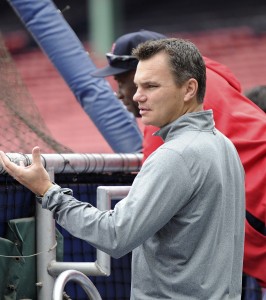It is somewhat amazing that there are three National League teams – one each for the West, East, and Central – that have yet to win their division.
Make no mistake, the American League has its share of heartbreak. The Mariners have yet to return to the playoffs after their 116-win season in 2001. The Rangers are far away as ever from capturing their first World Series after the so-close-you-can-taste-it near-misses of 2010 and 2011. Fans of the Astros and Red Sox have suffered different brands of heartbreak after the legitimacy of their recent winners was called into question.
But in the National League, the Rockies, Marlins, and Pirates have never won their respective divisions.
Granted, the Pirates were crowned champs of the National League East 9 times, including a three-peat for Jim Leyland’s clubs from 1990 to 1992 and a title-winner way back in 1979 – but since they moved to the NL Central in 1994: goose eggs. That’s a 26-year-run without a divisional crown, a mark of futility eclipsed only by the Rockies and Marlins. Colorado and Florida both entered the league in 1993, and neither has landed the top spot in their division in the 27 seasons since.
Back in the junior circuit, every team in the AL East has won since 2010 (Tampa Bay). In the Central, the White Sox have the longest drought (11 seasons), going back to their first-place finish in 2008. Everyone in the AL West has taken their turn at the top since 2012 – except the Mariners, of course, who won the division in 2001 and 1997.
But each division in the National League has its slow-and-steady competitor, so let’s take a quick look at each.
Colorado Rockies
Of these three clubs, the Rockies’ reputation took the fewest hits over the last 27 years. The Blake Street Bombers hold a particular place in baseball lore, and there’s a general sense of “unfortunate circumstances” around the Rox because of the thin air in Colorado. The impossibility of housing a winning pitching staff at Coors Field is baseball cliche now, but that doesn’t make the challenge any less potent.
Here’s what I wrote of Colorado in their Offseason In Review post back in March: “Colorado pitching, after all, has proven one of the more frustrating team-building challenges in the major leagues. The Sisyphean task of constructing even a league-average pitching staff at Coors Field persists year-after-year. Over the course of their 27-season history, the Rockies posted a league-average or better team ERA just three times (2010, 2009, 2007). In 2010, Jim Tracy’s 83-win squad finished with an exactly-league-average ERA, but those other two seasons — 2009, 2007 — happen to be two of the only three seasons in which the Rockies won 90 games in their history.”
Adding to the task at hand for Colorado, there’s at least a possibility that ownership believes this team is better than it is. They lost 91 games last year and have exhibited zero financial flexibility. If they end up losing close to 90 games again (or the equivalent in whatever kind of season is played in 2020), then the Rockies are still probably in the decline phase, not yet having rebooted into a full-blown rebuild. Rebuilds, of course, are time-intensive when done right, and very time-intensive when rushed.
The Rockies have made the postseason a handful of times, and they won the pennant in 2007, but they’re caught in no-man’s-land now. The Dodgers have won the division 7 years running, and Walker Buehler, Cody Bellinger, and company have plenty left in the tank. The Padres’ stable of young arms makes them one of the more intriguing up-and-coming teams in the league, and the Diamondbacks continue to impress with their ability to retool on the fly. After coming within a play-in game of taking the crown from the Dodgers in 2018, the Rockies might have missed their best shot.
Miami Marlins
The Marlins entered the league at a tough time to be a member of the NL East. The Atlanta Braves held a hammerlock on the division, taking the crown every season from 1995 until 2005 (they were in the NL West before that). To their credit, the Marlins made themselves into a competitive squad pretty quick, making the playoffs as a wild card in 1997, just their fifth season of existence. The organization made its name the year after, however, in selling off the pieces of their World Series winner and cratering into a 108-loss squad. After that horrid 1998 season, it took the Marlins five more years to get back to the playoffs again, at which point it was second-verse-same-as-the-first. They didn’t sink quite so fast or quite so far the second time around, but they also haven’t recovered (no playoff appearances since 2003).
That said, the Marlins have begun to see the light from their decade-plus in limbo. MLBTR’s own Mark Polishuk wrapped up the Marlins offseason back in March with this: “It’s a sign of progress, however, that the scorched-earth phase of the rebuild seems to be over. Villar, Kintzler, or other veterans on short-term deals could well end up being moved at the trade deadline, but it doesn’t seem like younger talent is on the move…Miami seems ready to find out if the young players it already has in the fold could end up being part of that next Marlins winner, and it will be intriguing to see which of the pitchers and position players take that next step in 2020.”
The current era of Marlins baseball is best known for shepherding the likes of Giancarlo Stanton, Christian Yelich, and Marcell Ozuna out of town prior to the 2018 season. But they’re also a unique entrant on this mini-list because they won not just one, but two World Series titles over this span. Derek Jeter now helms the organization, and though they don’t have that face-of-the-franchise type player soaking up their spotlight, they’ve become increasingly competitive. Heading into whichever season of baseball comes next, they’ll have a decent collection of starting pitchers to keep them in games – with a smaller host of position player prospects nearing the majors. Whether they have that franchise-changing talent in the upper ranks is unclear. Business might not yet be booming in Miami, but it’s better.
Pittsburgh Pirates
As stated above, it’s a bit unfair for the Pirates to be lumped in with the expansion clubs from the nineties, as they do have a history of success in the major leagues. They have 9 division crowns, 7 World Series appearances, and 5 World Series banners. But that’s all ancient history.
Since moving to the NL Central in 1994, the Pirates are a firm contender for the most moribund franchise in the sport. The departure of Barry Bonds after the 1992 season put an unfortunate face on their decline – much in the way that Babe Ruth’s departure doomed Boston baseball for so long – but there has been ample time to rebound from those back-to-back game 7 losses to Atlanta in 1991 and 1992.
In the time since the Pirates’ primary distinction is claiming the title for the longest streak of losing seasons in North American sports history. Forget about division titles. The Pirates weren’t able to finish over .500 one time from 1993 to 2012.
Pittsburgh fans finally had something to cheer for in 2013 when Clint Hurdle’s club broke through with 94 wins and a wild card berth. They even won that first playoff game against the division rival Cincinnati Reds and pushed another rival – the Cardinals – to five games in the NLDS. The club followed its star outfield of Andrew McCutchen, Starling Marte, and Gregory Polanco to two more wild card berths in the following two seasons. Unfortunately, they were unable to get more than one playoff game in either of those years.
After finishing over .500 again in 2018, last season brought on a complete reset. Most of the organizations’ management turned over, and the remaining faces of those competitive clubs – Hurdle, Marte – were also sent packing. The organization is now in the hands of GM Ben Cherington, but they’re facing a complete philosophical overhaul. While they have talent, they’re not an easy club to put a timeline on returning to contention. Not until they put together a pitching staff with a more effective (and less pugilistic) philosophy. The division isn’t dominated by one team like the current AL West, but the Cardinals build a winner year after year, and the Cubs and Brewers aren’t far off in terms of their recent consistency.
Looking ahead, a shortened season in 2020 could open the window for a bizarre sort of division champ. All hope is not lost. On the whole, however, I don’t think there are a lot of pundits who would pick any of the Rockies, Marlins, or Pirates to breakthrough next season. Still, it’s bound to happen one day, right? All three teams will work to end their respective droughts, and in the meantime, thank goodness for the wild card.
(Poll link for app users.)
(Poll link for app users.)

